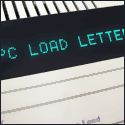|
I sold my MKII a few months ago and I doubt I'll ever regret it. After 2 years it just started to feel like an expensive dongle that for NI's purposes exists solely to sell expansions. My initial plan was to use it as a final solution to drums - but integrating it into my own workflow made my life hell. Its fine to start loops or projects with - but as soon as you want to transfer these ideas to a daw timeline you start hitting its limitations pretty quickly. Too slow and cumbersome - and it wants to do too much without really nailing any of them. There are improvements in the beta pipeline but they are saving the best ones for 3.0 (paid update, naturally); and when I realized that I decided to sell. Jumped on the elektron bandwagon instead and couldnt be happier about it. It feels like im working with instruments again, as opposed to overpriced laggy midi controllers for a bloated software.
|
|
|
|

|
| # ? Jun 8, 2024 22:44 |
|
Quincy Smallvoice posted:I sold my MKII a few months ago and I doubt I'll ever regret it. After 2 years it just started to feel like an expensive dongle that for NI's purposes exists solely to sell expansions. My initial plan was to use it as a final solution to drums - but integrating it into my own workflow made my life hell. Its fine to start loops or projects with - but as soon as you want to transfer these ideas to a daw timeline you start hitting its limitations pretty quickly. Too slow and cumbersome - and it wants to do too much without really nailing any of them. There are improvements in the beta pipeline but they are saving the best ones for 3.0 (paid update, naturally); and when I realized that I decided to sell. That fairly closely mirrors the complaints I've read elsewhere. I'm guessing you're using the Analog Rytm MKII? I looked at it, and it looked thoroughly great, but $1500 is a bitter pill.
|
|
|
|
TheQuietWilds posted:(more at GS than the other places, and I generally assume everybody there is a grognard) this is truth
|
|
|
|
Quincy Smallvoice posted:as soon as you want to transfer these ideas to a daw timeline you start hitting its limitations pretty quickly. Too slow and cumbersome Out of curiosity, what limits are you hitting? I have never heard that as a criticism of it before. I'm not trying to defend it but I have a rytm too - and that I find slow and cumbersome to bounce down because I am so used to maschine being able to bounce down 10 separate channels a minute each in under 30 seconds. An entire maschine project can be relaid out in ableton in under 5 minutes, it's genuinely one of my favorite things about it and why I will continue to use it. cubicle gangster fucked around with this message at 21:28 on Oct 20, 2017 |
|
|
|
cubicle gangster posted:Out of curiosity, what limits are you hitting? I have never heard that as a criticism of it before. These issues ARE being discussed on the NI forums though (and the beta forums). There's a reason why they started realizing it needed work. But my problem was just adding fills/variation and other randomness in a more natural and creatively satisfying way. I only have a digitakt so I dont even have overbridge yet - but the conditional triggers have really saved my life. Like I said there are solutions available in the maschine beta; but its not likely to be released until 3.0 (my guess).
|
|
|
|
I'm just mad that the downloads for maschine packs i need keep hanging ever since i uninstalled/reinstalled
|
|
|
|
Quincy Smallvoice posted:These issues ARE being discussed on the NI forums though (and the beta forums). There's a reason why they started realizing it needed work. . So it's not actually a problem you've had yourself? I don't even know what it is but if you think bouncing elektron gear down is faster than a maschine I think you been using the latter wrong. And I love elektron gear.
|
|
|
|
cubicle gangster posted:So it's not actually a problem you've had yourself? gotta read the whole post fam
|
|
|
|
am I losing my mind or are Dillon Francis tracks super loving loud to the point it's weird?
|
|
|
|
Oh he's loud, but nothing especially abnormal. When I think loud (perceptually), I think Dark Synthwave music like Perturbator and Carpenter Brut- but that's partly by design. As for technical/objectively loud, I can only speak to tracks I've used as references (and personally saw their RMS/Peak values), Dillon Francis has virtually always been crunchy and maximized- but 2012ish was so far the peak of the trend. I remember seeing songs like Tommy Trash - Truffle Pig with an RMS between -1.5 and -1.0 and a peak of 0. Skrillex - Bangarang was also famously over-maximized, and I saw a few other late electro house and dubstep tracks with similar dynamics as well. Perhaps someone more knowledgeable of the industry can tell me- have they been pulling back on the loudness wars as of late? Because it feels that way.
|
|
|
|
I don't think it sounds bad, and you're definitely right about thing calming down since 2012. Check out how loving loud this is, even in spotify: https://open.spotify.com/track/2SHqrEpgmnKnVBOHJtIA9B It's super present and crunchy but not what I'd call ruined, not by a longshot. It's actually pretty impressive how clear it comes out considering how big it is. I guess dude makes loud as gently caress party music and it's mixed well for that application. I think the loudness is getting dialled back slowly as various services are normalising everything by default, we were talking about this a few weeks ago, I think in this thread. Less of a reason to slam everything to slam out if the streaming service is just going to lower the overall level.
|
|
|
|
Yah Dillon Francis has always stood out to me as being perceptually loud. The producer that I literally have to turn down my car stereo for when tracks come on though is Mord Fustang. His latest track made me think of this again. https://soundcloud.com/mordfustang/because-of-you
|
|
|
|
Some of the more aggro dubstep guys are still unbearably loud, but I quite like it. Putting them into a mix with other tracks is tough though. https://soundcloud.com/phiso/perish-song https://soundcloud.com/oolacile/riddumb The half-time scene is also like this, Bleep Bloop, Aleph, etc. https://soundcloud.com/renrakuglobalmedia/aleph-the-evil-spirit-1
|
|
|
|
I have a dumb question and it looks like the thread is already talking about that topic so; how do you make stuff loud(er)? As a hobbyist I haven't paid much attention to making my stuff loud (I'm basically the only one listening to it anyway  ) and I have very limited knowledge about mixing and mastering, but one thing I've noticed is that the stuff I export is very quiet compared to, well, everything else. This is especially apparent when I try to recreate songs (it's fun, don't judge) and even with both songs normalized mine sounds like it's several dB quieter. I'm pretty sure the answer includes the word "compressors" but the way people talk about compressors online you'd swear it was literal voodoo. I get the theory behind 'em on a technical level, but how to actually apply them is a different story, especially when so much of these resources seem to be aimed for live musicians (e.g. how to use compressors for guitars, live drums, vocals, etc.) and not bleepbloops. ) and I have very limited knowledge about mixing and mastering, but one thing I've noticed is that the stuff I export is very quiet compared to, well, everything else. This is especially apparent when I try to recreate songs (it's fun, don't judge) and even with both songs normalized mine sounds like it's several dB quieter. I'm pretty sure the answer includes the word "compressors" but the way people talk about compressors online you'd swear it was literal voodoo. I get the theory behind 'em on a technical level, but how to actually apply them is a different story, especially when so much of these resources seem to be aimed for live musicians (e.g. how to use compressors for guitars, live drums, vocals, etc.) and not bleepbloops.
|
|
|
|
Well here's my explanation of compression with minimal voodoo, even though that is contrary to the halloween spirit original:  compressed:  There is now less variance in the volume level. The perceived effect of this to the human ear is that the entire thing sounds "louder", even though the peak volume is the same. An over-compressed waveform might look something like this:  Again, the peak volume never actually goes any higher than the original audio, but the overall volume is higher. You could think of this process as "making the quieter bits louder" but most compressors don't work that way on a technical level. Instead a compressor will generally do the opposite (make the loud bits quieter) and then there will be a parameter for gain or makeup to bring the volume level back up after the compression. So in reality something more like this process is happening: original:  compressed:  makeup:  Generally you have a threshold parameter for dialing in the minimum volume at which the compressor starts to take effect. Usually there's some kind of knee which means the compressor becomes gradually more active depending on how far past the threshold the volume is. The overall intensity of the compression is usually expressed as ratio but you could just think of that knob as meaning "amount of compression". Most compressors basically work this way and if they don't they usually tell you about it in the marketing text. The process is going to be pretty much the same regardless of the source material and I think the reason most resources will give live guitars and drums etc as examples is mainly for familiarity. Percussive elements such as drums are sometimes processed in a way that retains the transients of the drum hits, meaning the tail of the sound is compressed but the start is not, so you still hear a bit of "snap" at the beginning where the drum is hit. This is generally what the attack and release parameters of a compressor are used for. The attack affects how long it takes for the compressor to fully kick in once the threshold level is hit. Another kind of compressor is called a limiter (sometimes called a maximizer). This is simpler in operation than a typical compressor: it just puts a hard limit on the volume level of the audio, so if you have your limiter threshold set to - 3db, the sound will never ever go beyond - 3db no matter how high you crank the gain before the limiter. Generally there is some kind of softening to keep things from sounding too harsh as the - 3db threshold is approached, so it's less of a "hard clip". Because a limiter has a less "characterful" sound (voodoo words sorry) than a traditional compressor it's typically used just to catch stray peaks in the audio rather than to increased perceived volume levels. Often you get people asking things like "should i put a compressor on every track" or "should i put one on the master bus" and, as annoying as this may sound, the correct answer is usually something along the lines of "it depends on the track" or "if you want to". The other thing I would suggest particularly with regards to bleepbloops is to try to understand the importance of EQing for making sure each element is leaving enough space for the rest. Creating a "fuller" mix which covers the entire frequency spectrum will also do a lot to affect the perceived loudness of the song. Try to watch out for, and EQ away any extremely low or extremely high frequencies as these will interfere with compressors in weird ways. Like if you have some kind of low hum at around 20Hz that you can't even hear with your headphones then it may still trigger the compressor and mess up the sound, so a visual frequency analyser is useful. Dicky B fucked around with this message at 18:55 on Oct 30, 2017 |
|
|
|
The explanation above is incredibly good. The only thing I would like to add is that the "variance in volume level" of a particular piece of audio is called its dynamic range. Compression essentially reduces the dynamic range or "variance" of a piece of audio. But compression is just one of the many tools that make a song "loud". There are many important steps in the production, mixing, and mastering process that will contribute to making a song perceptually loud. Over-compressing a piece of audio can actually make something have less impact. If everything is at the same volume, your ear can't perceive any piece as louder or quieter, so it ends up falling flat.
|
|
|
|
Wowza, yeah. That's a pretty great explanation MrSargent posted:Over-compressing a piece of audio can actually make something have less impact. If everything is at the same volume, your ear can't perceive any piece as louder or quieter, so it ends up falling flat. the question: I've found it hard to make something louder without ruining the kick drum, that is, it loses its impact completely. How do people manage to have louder everything else while also having a punchy kick? Assuming everything isn't squashed and over-compressed, then maybe careful EQing so the kick doesn't fight for space is the key? And of course there's sidechain compression but I feel like that's pretty drastic in a lot of cases.
|
|
|
|
A big part of making use of all that makeup gain is also making sure all of your sounds have their own space in the mix and no frequencies clash - very well spaced mixing allows it to be perceived louder. That's your kick drum issue, keep reading into it. There are some new software tools that allow you to compare multiple channels of audio and it flashes where there are clashing frequencies so you can pick one to cut. I've not used any yet (I think ozone makes one) but it seems to be a a solid shortcut. cubicle gangster fucked around with this message at 05:57 on Oct 31, 2017 |
|
|
|
Izotope's Neutron does that. The only issue with those sorts of plugins is they go 'this is clashing' and analyse it from a purely scientific rather than emotional or artistic perspective. Whilst a lot of the time clashing frequencies (especially in bass registers) are detrimental, there can be occasions where frequency overlap can add to a tune, software can tell you it's happening but it can't decide for you if it's actually beneficial to the song. Stereo width can often help with making stuff 'loud', have your kick and bass centred, which is good practice anyway and pan other midrange or treblier elements wider to the sides to give them space without comprising volume.
|
|
|
|
One easy exercise to try is to use an analyzer to find the fundamental frequency of your kick. Maybe it's around 50Hz. Then route all your other tracks to a single bus and simply use an EQ to create a dip at 50Hz to create room for the kick, and see how that helps. This is probably not the greatest approach for every mix but it may be a useful learning exercise. Obviously you might hear your bass lose some energy and in fact dealing with the interplay between kick and bass is, these days, often dealt with using some kind of dynamic ducking technique instead. Sidechain compression is very popular now but I can't give much advice there. Another thing to be aware of is the kick is not always just low-end. Many kick sounds actually have some kind of high-frequency content which is sometimes referred to as the "click". This is sometimes created by simply having a very fast attack. Some kick drum synthesis techniques actually involve using two oscillators - one to synthesize the main boom of the kick and another oscillator to create a short, high-frequency "click" sound, so it's considered an important and intentional part of the sound which can really help the kick cut through the mix. The low-end "boom" of the kick doesn't always need to be particularly loud for the kick as a whole to be perfectly present.
|
|
|
|
Dicky B posted:Another thing to be aware of is the kick is not always just low-end. Many kick sounds actually have some kind of high-frequency content which is sometimes referred to as the "click". This is sometimes created by simply having a very fast attack. Some kick drum synthesis techniques actually involve using two oscillators - one to synthesize the main boom of the kick and another oscillator to create a short, high-frequency "click" sound, so it's considered an important and intentional part of the sound which can really help the kick cut through the mix. The low-end "boom" of the kick doesn't always need to be particularly loud for the kick as a whole to be perfectly present. Another thing I want to throw into the hat is the consideration whether it is really necessary at all to make the mix as loud as every other mix if it's really costing you meaningful impact. Arguably the world is slowly moving towards playback systems where music is level matched for psycho-acoustic loudness (analogous to replay gain) instead of loudness relating to the absolute 0dB point of your media. In this system, a more squashed mix is just that and any making the mix louder against the absolute frame of reference is simply and intentionally negated during playback. We're talking platforms like radio and tv, but also itunes and spotify. While it's a useful skill to know how to deal with clashing frequencies anyway (by all means, teach yourself that), maybe the need for absolute loudness and the compromises that come with it grow less self evident, as what was a competitive advantage (louder music) is turning into a disadvantage (compromised dynamics). In this newer system, you'd volume level your reference material in the same way the playback system would and you wouldn't be caught in the illusion that your lesser compressed mix was necessarily sounding weaker. The flip side is that on playback systems that haven't (or can't) implement it, like cd or soundcloud (I think), the mix still may sound quieter than everything else. I think there's room to accommodate both systems, where you can aim for a moderately loud mix while letting go of absolute loudness as the all-overriding factor. If my kicks sound punchy because they have big peaks, maybe that's more or less how they need to be? It's easy for me, with no audience to offend or fail to persuade. I just make the mix I think sounds best. If you're actually "competing" for attention, maybe your compromise is somewhere else. Wherever you ultimately end up, it's becoming something to consider, I think.
|
|
|
|
I long for a world with no loudness wars. Thankfully since I'm just doing bleepbloops as a hobby it hasn't really impacted me and like I said it's not like people are listening to my stuff anyway, but it has been a minor annoyance the few times I share stuff with other people. No one likes fiddling with the volume slider 
|
|
|
|
speak for yourself I call mine freddy and we tight as hell ok
|
|
|
|
This is a great free maximizer: http://www.yohng.com/software/w1limit.html It's a 1:1 copy of the famous Waves L1, completely legal (clean-room reverse engineering). That being said, if you're doing bleep bloops, consider putting clippers on some channels that won't mind having their peaks shaved. I love GClip for that purpose because it has a neat display that will immediately show you if you're cutting too much. This will distort your transients, but without the pumping normally associated with limiters and for some genres (electro/chiptune) might result in an actually preferable sound.
|
|
|
|
Keep in mind that absolute loudness is a big part of making something pop out of a radio station or playlist, but relative loudness is what makes something sound "big" inside the track. Manipulating this idea goes a long way. A big part of what you're hearing in super loud mixes that still manage to have super forward kick sounds in dense hiphop/edm tracks isn't actually maximizers so much as side chain compression. Sidechain compression works by having the thing that is triggering the compressor not be the same source as the audio getting effected by the compression. Usually people run the stereo master (minus the kick) through a fast, higher-ratio limiter, and side chain the kick track (so the kick activates compression) - this has the effect of subtly dropping the level of the overall mix every time the kick hits, creating space for a perceptually massive kick. It also gives the track a sort of pulsating effect that works really well in EDM in particular.
|
|
|
|
Cross-posting from the synth thread - I'm angry at the difficulties of workstations as opposed to discrete drum/key/synth units. Is it possible to use FL Studio to power a JX-03 Roland Boutique + TR-505 drum machine + TB-03 Bass Synth (or Minitaur or whatever) to record songs to mp3/etc. without it being a major pain? I assume I'll need a USB->Midi interface with a few ports and for all of the things to actually physically connect - but how would sound get back into the DAW? Buying a mixer and routing all the cables back into an audio interface sounds horrible. Southern Heel fucked around with this message at 13:16 on Nov 8, 2017 |
|
|
|
Southern Heel posted:Cross-posting from the synth thread - I'm angry at the difficulties of workstations as opposed to discrete drum/key/synth units. Audio: JX-03: Unbalanced Stereo I/O, USB interface TB-03: Unbalanced Stereo I/O, USB interface TR-505: Stereo Out MIDI: JX-03: MIDI In & Out/Thru, USB interface TB-03: MIDI In & Out/Thru, USB interface TR-505: MIDI In & Out/Thru You've got a couple options: 1) Replace the TR-505 with either a TR-08 or TR-09 and get a cheap powered USB-Hub. plug all three of the Roland Boutique USB I/O into that and use just USB. 2) Buy an audio interface that comes with a MIDI out, put them all on different channels, and make a MIDI chain, sending all the analog inputs back into the analog in. I'd recommend something like the MOTU Ultralite MK4. The advantage of 1 is that it replaces the weak link with something stronger and it will probably be significantly less complicated to set up. The advantage of option 2 is that if you decide to expand to modules that don't have specific USB-I/O you can, because Analog I/O on 1/4in TRS and non-USB MIDI are really universal. It also allows you to buy a microphone and make samples or record vocals/guitars/etc. You decide what's important to you.
|
|
|
|
Hook up all that via USB but for the 505 you will need an USB MIDI cable or interface. There are mixers that are audio interfaces at the same time but cheap ones have no/poo poo ASIO drivers and only stereo out. Otherwise you end up with a Presonus StudioLive or something. There is a smaller cheaper version out called the AR12, perhaps that's something? Zoom makes an interface plus mixer plush flash-based harddisk recorder but I don't know how well it performs. A rack audio interface can be combined with a control surface if you insist on having sliders.
|
|
|
|
Laserjet 4P posted:Zoom makes an interface plus mixer plush flash-based harddisk recorder but I don't know how well it performs.
|
|
|
|
Thank you both - as per the synth thread I think it might be better to consider these as separate concerns: I didn't factor in the complexity of connecting them all together and making music outside the realm of a DAW and as such may make the requirement for hardware moot. To put the question back on its head, I've got a Windows 10 workstation at the moment, a decent enough audio interface and a big midi-USB piano.TheQuietWilds posted:spending hundreds on VSTs and sample packs (which you should really not do) In the past I've gone full pirate and got FL Studio 12 and various expensive Korg, Roland paid-VSTs and sample libraries. Let's take it for granted that I'm going to go full legit. It would appear this hybrid song/live jam method makes Ableton a key choice. I've got the demo and I'm running through it now - I know how synthesis works and I don't need flashy software as per above. Is there anything I _DO_ need to go forward for the synthwave/darksynth route I'm interested in at the moment?
|
|
|
|
Southern Heel posted:Thank you both - as per the synth thread I think it might be better to consider these as separate concerns: I didn't factor in the complexity of connecting them all together and making music outside the realm of a DAW and as such may make the requirement for hardware moot. To put the question back on its head, I've got a Windows 10 workstation at the moment, a decent enough audio interface and a big midi-USB piano. Ok Ableton Live comes in three versions: Lite, Standard and Suite ($80, $360 & $600 respectively). Lite is probably not worth discussing, it comes free included with stuff all the time and is designed to be annoyingly incomplete to prod you into buying a more expensive version. The main difference between Standard and Suite is included effects, sounds and software instruments. The main things you're missing for making synthwave with standard relative to Suite are below: Sounds: Retro Synths VSTs Analog (Analog Synth emulator) DrumSynths (Drum synths) Operator (FM synth emulator) Sampler (more complicated version of Simpler) Tension (Strings emulator) MIDI Effects Arp (Arpeggiator) Envelope Envelope Follower Expression Control LFO/LFO MIDI I use Logic (and I'm sort of new at that, tbh) so I'm probably not the best judge of how good their Retro Synth sample pack and Analog/FM Synth VSTs are, but most of those things aren't really necessary for beginners, they're kind of advanced. The two that you might want to research freeware/cheap alternatives to are Operator and Analog. If you've already got an audio interface you need a good pair of monitors and headphones. So to specifically answer your question: Necessary: Headphones, Monitors Nice but not critical: Standard->Suite Upgrade, a few more VSTs Luxury: Flagship VST synth like Omnisphere, Serum or Native Instruments stuff (Reaktor/Kontakt or Komplete)
|
|
|
|
And that is exactly why I keep thinking to myself it would be a better option to go with hardware - $600! For software! Obviously I'm going to need Analog/FM Synth emulators, Arpeggios, etc. 
|
|
|
|
Southern Heel posted:And that is exactly why I keep thinking to myself it would be a better option to go with hardware - $600! For software! Obviously I'm going to need Analog/FM Synth emulators, Arpeggios, etc. Ummm, hardware is almost never going to be a cheaper option than software.
|
|
|
|
A minimal setup would probably be something like an Arturia Beatstep Pro ($250) for sequencing, a drum synth like DrumBrute ($445), and a small analog monosynth like a Korg MS-20 mini ($450). Now you've got a barebones system for making noise after spending >$1100, everything is monophonic-only and can't actually record the sound you're making. Those are all pretty bare-bones and low-price modules. Alternatively, for $600 you get to use your nice MIDI piano in a convenient way to control 13 different synths, with 18 midi effects, 55gb of samples, complex polyphonic sequencing, multitrack recording, deep editing and sampling capabilities and nearly infinite expandability. It's not a bad deal. Ableton Live is a serious professional quality tool with literally everything you need to make music included, outside of a MIDI controller and some way to listen to what you're doing with any level of accuracy and detail. https://www.ableton.com/en/live/compare-editions/ TheQuietWilds fucked around with this message at 19:09 on Nov 9, 2017 |
|
|
|
OK so I'm going to cool my heels but I get the point. I've got another 4 weeks of the Ableton Live Suite demo to go through, so if I find myself going at it in anger then I guess that might be something to look at.MrSargent posted:Ummm, hardware is almost never going to be a cheaper option than software. Right, but if I buy a used TR-03 for £200 I can sell it for £180 in a year's time. If I buy $600 then it's just gone.
|
|
|
|
License transfers are allowed for Live. You don't get as quite as much for license transfers as you do for used hardware, but because Live is so popular it's not that far off and is also easy to move, unless things have changed a lot the past couple years. I don't recall if they allow transfers of transferred licenses but if it's not in some FAQ on their site I'm sure they'll tell you if you ask them.
|
|
|
|
What's the weirdest thing you've ever sampled?
|
|
|
|
A groan tube from the 90s Alternatively, every single container in my home that can be shaked, from a salt shaker to dish detergent box to Special K.
|
|
|
|
Southern Heel posted:Right, but if I buy a used TR-03 for £200 I can sell it for £180 in a year's time. If I buy $600 then it's just gone. Protip: people sell secondhand Ableton Live licenses. Very few people have a completely DAWless setup, and you almost never need the highest priced version with all the bells and whistles because most of the stuff that is added is something you can buy later or by third parties. Except for Max for Live, something like Komplete offers more and better than what Live Suite comes with. Also depreciation is never about percentages but about absolutes. A TB-03 is not a replacement for Live. If you had to replace that functionality in software we would be talking multitrack harddisk recorders, digital mixers, synths, effects, etc. Think of all the things you had to buy separately if you wanted to replace a smartphone. Itís literally this:  On a sidenote gently caress imgur for removing board share links on mobile Laserjet 4P fucked around with this message at 16:26 on Nov 28, 2017 |
|
|
|

|
| # ? Jun 8, 2024 22:44 |
|
Iím planning to start releasing my techno stuff under a different alias, White Collar Sex Machine (WCSM). Just a fun phrase I heard in a Cracked video that I think would be good for an act. Iím close to having my first full length album done, just self released or bandcamp for time being. My friend is absolutely convinced this will cause problems because of the group Black Tiger Sex Machine (BTSM) already existing. The fact theyíre label heads, Canadian like myself, and still active convinced him this is the case. He says I should instead produce it under the JVNO moniker (pronounced Juno- Iím using the V/U switch for search visibility). Youíll notice this is my username here: itís a name I kind of Ďparkedí for the nuwave/synthpop poo poo I do, but havenít actually released anything under yet. Any thoughts from people more knowledgeable than I would be cool- could a litigious group make a case about Ďsex Machineí being common to both names?
|
|
|

























